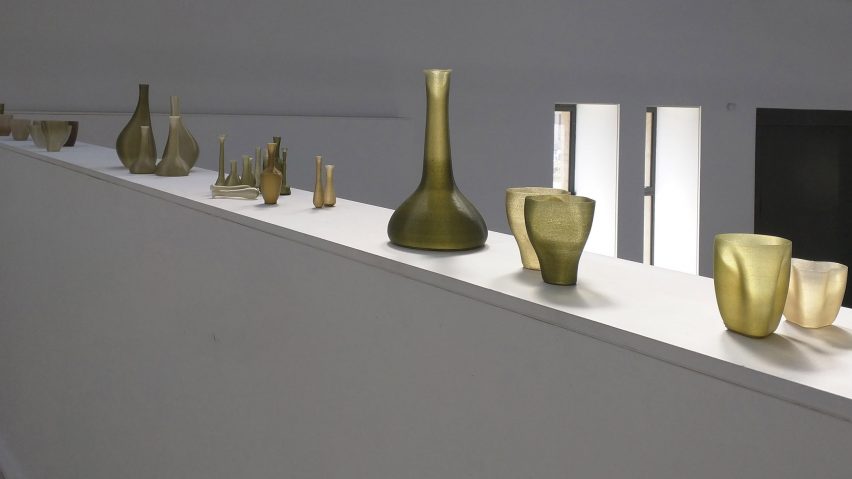Could biodegradable plastics made from natural substances such as algae replace fossil-fuel polymers? Here are 10 examples of designers that are experimenting with environmentally friendly alternatives.
Istanbul Design Biennial curator Jan Boelen told Dezeen last week that the trend for designing with recycled plastic is "bullshit", as it perpetuates the global dependence on fossil-based polymers. He has instead called for more research into bioplastics, which are made from natural materials.
There are a number of designers already experimenting with bioplastics made from everything from corn starch to beetle shells.
Here are 10 of the most innovative examples:
3D-printed biopolymer plastic by Erik Klarenbeek and Maartje Dros
Dutch designers Erik Klarenbeek and Maartje Dros are trying to establish a network of biopolymer 3D-printers called the 3D Bakery, which would mean that people could print their own environmentally friendly products.
They set up their own facility at Atelier Luma in Arles to demonstrate the concept. Called AlgaeLab, it provides a facility for cultivating, harvesting and drying algae, so that its starch can become the raw material for bioplastic.
They have also created pop-ups in different locations, such as the Museum Boijmans Van Beuningen in Rotterdam, and created 3D printed objects using algae found on site.
Find out more about 3D Bakery ›
That's It packaging made from algae by Austeja Platukyte
Austeja Platukyte has developed a biodegradable material made from algae that could replace regular crude oil-based plastic packaging.
Presented in her graduation show from the Vilnius Academy of Arts, That's It is made from only two ingredients: agar derived from algae, and calcium carbonate strengthened with an emulsifying wax.
The designer proved that the lightweight, waterproof material decomposes by burying it in the ground and regularly monitoring.
Find out more about That's It ›
Biodegradable algae water bottles by Ari Jónsson
Ari Jónsson, a product design graduate from the Iceland Academy of the Arts, used algae to create an alternative to the plastic water bottle.
To make the bottles, he slowly heats a mixture of agar powder and water, before rapidly cooling it and turning it in an ice-cold mould.
The bottle keeps its shape whilst full of water, but will start to decompose when empty. Liquids stored in the bottle are entirely safe to drink, and drinkers can also snack on the bottle itself.
Find out more about the biodegradable algae water bottles ›
Sea Me seaweed furniture and bioplastic bowls by Studio Nienke Hoogvliet
The seat fabric for Nienke Hoogvliet's Sea Me furniture collection is woven by hand from seaweed yarn, a material with similar properties to viscose, but made from cellulose extracted from kelp.
She then uses seaweed leftover from the production process to make bioplastic bowls. The designer's belief is that in future we might all live in houses produced and furnished entirely with seaweed.
Trainers with a bioplastic sole made from corn by Reebok
The sole of Reebok's Cotton + Corn sneakers is made from corn, and the insole is derived from castor bean oil. With a cotton upper, the shoe is 75 per cent bio-based, but performs like any other similar sneaker.
The corn sole was made in collaboration with DuPont Tate & Lyle, using their Susterra propanediol material, which can also be used as an bio-based engine coolant, and as the glycol element in the manufacture of resins for the boating and car industries.
Find out more about Cotton + Corn ›
Botanical figurines made sugar cane-based bioplastic by Lego
Lego used a polyethylene plastic made from ethanol produced from sustainably sourced sugar cane for the trees, leaves and other vegetation in its range. It hopes to produce all Lego pieces from the bioplastic by 2030.
As well as looking towards bioplastics, Lego has invested in wind power to offset the energy used in making its bricks, and introduced sustainable paper pulp trays for its advent calendars.
Find out more about Lego's sustainable bricks ›
Coleoptera bioplastic made from beetle exoskeletons by Aagje Hoekstra
Aagje Hoekstra developed bioplastic made using from the tough outer shell of the darkling beetle. The dead beetles are a by-product of the mealworm animal feed industry.
Hoekstra peeled the beetles and was left with a natural polymer called chitin, which she converted to chitosan with a chemical process, then heat-pressed to form a waterproof, heat-resistant bioplastic.
Find out more about Coleoptera ›
Crustic bioplastic made from crab shells by Jeongwon Ji
As with beetle exoskeletons, the shell of crustaceans contains the chitin polymer. Jeongwon Ji combined this with water and a small amount of glycerin, on a trial and error basis, to produce a bioplastic.
Called Crustic, the project stemmed from an increase in invasive Chinese mitten crabs in UK waters, as a way of using the creatures which were seen as pests as a useful resource. The designer used it to create plastic casings for small electronic objects, such as alarm clocks.
FORMcard bioplastic card by Peter Marigold
London designer Peter Marigold created a non-toxic but brightly coloured bioplastic card, the size of a regular credit card, that softens in water and can be used to mould hooks, repair plastic objects, and child-proof table edges.
Similar to the mouldable rubber glue Sugru, Marigold's card was made from a starch-based bioplastic and contained colour pigments rather than the universal pigments more commonly used in plastics.
Find out more about FORMcard ›
Students from Stuttgart University's ITKE – a research unit that regularly builds pioneering pavilions – designed this spiky curving pavilion to demonstrate the properties of a bioplastic developed for the construction industry.
Called Arboblend, the material is produced by German firm Tecnaro. It combines biopolymers such as lignin – a by-product of the wood pulping process – to create thermo-formable sheets of bioplastic. The sheets are heated to be formed into the faceted shapes. Waste plastic can be granulated to be reused.
Find out more about ArboSkin ›

